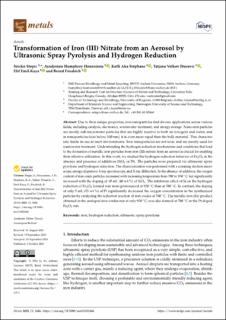| dc.description.abstract | Due to their unique properties, iron nanoparticles find diverse applications across various fields, including catalysis, electronics, wastewater treatment, and energy storage. Nano-iron particles are mostly sub-micrometer particles that are highly reactive to both air (oxygen) and water, and in nanoparticles (size below 100 nm), it is even more rapid than the bulk material. This characteristic limits its use in inert environments. Iron nanoparticles are not toxic and are mostly used for wastewater treatment. Understanding the hydrogen reduction mechanisms and conditions that lead to the formation of metallic iron particles from iron (III)-nitrate from an aerosol is crucial for enabling their effective utilization. In this work, we studied the hydrogen reduction behavior of Fe2O3 in the absence and presence of additives (SiO2 or Pt). The particles were prepared via ultrasonic spray pyrolysis and hydrogen reduction. The characterization was performed with a scanning electron microscope, energy-dispersive X-ray spectroscopy, and X-ray diffraction. In the absence of additives, the oxygen content of iron oxide particles decreased with increasing temperature from 700 to 950 °C but significantly increased with the doping of 10 mL (40 wt.%) of SiO2. The inhibitory effect of Si on the hydrogen reduction of Fe2O3 formed was more pronounced at 950 °C than at 700 °C. In contrast, the doping of only 5 mL (15 wt.%) of Pt significantly decreased the oxygen concentration in the synthesized particles by catalyzing the reduction reaction of iron oxides at 700 °C. The metallic iron (Fe) product, obtained in the undoped iron oxides run at only 950 °C, was also formed at 700 °C in the Pt-doped Fe2O3 run. | en_US |

